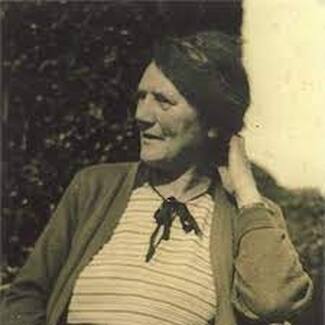NAN SHEPHERD (1893-1981)

Anna ‘Nan’ Shepherd was a Scottish Modernist writer and poet, best known for her seminal mountain memoir, The Living Mountain, based on experiences of hill walking in the Cairngorms. This volume has been described as 'the finest book ever written on nature and landscape in Britain'.
Anna (Nan) Shepherd was born on 11 February 1893 at Westerton Cottage, Cults on the western outskirts of Aberdeen, the daughter of John and Jane Shepherd. Shortly after her birth, the family moved to Dunvegan, on the North Deeside Road in Cults, the house she then lived in for most of her life.
She was educated at Aberdeen High School for Girls and graduated from the University of Aberdeen in 1915. Shepherd lectured at the Aberdeen College of Education for most of career, before retiring in 1956. She continued to edit the Aberdeen University Review until 1963. The University of Aberdeen awarded her an honorary doctorate in 1964. She was a close a friend and a supporter of other Scottish writers, including Neil M Gunn, Marion Angus and Jessie Kesson.
Throughout her time working at Aberdeen College of Education, Shepherd was an active writer. She was a significant contributor to early Scottish Modernist literature with her first novel, The Quarry Wood (1928) often being compared to Grassic Gibbon's Sunset Song which was published four years later. Both novels depict the constrained and often tragic lives of women in Scotland at that time. Her second novel, The Weatherhouse (1930), explores the lives of the women of the small town of Fetter-Rothnie and is an exquisite portrayal of a community coming to terms with the brutal losses of the Great War. Her third and final novel, A Pass in the Grampians, was published three years later in 1933.
Shepherd's novels are rooted in the communities that she recognised and understood. The highlight conflicts between tradition and modernity and the issues and challenges facing women in a time of profound social and cultural change. The landscape and the landscape of the North-East of Scotland are strongly evident in her fiction; indeed, the landscape can be said to be, almost, a character in its own right.
Shepherd was a keen hillwalker, and this is a dominant theme in both her poetry and her non-fiction work. She expresses her love for the mountainous Grampian landscape. As a student at university, Shepherd wrote poems for the student magazine, Alma Mater, but not until 1934 that a collection of her poetry, In the Cairngorms, was published.
Shepherd's short non-fiction book The Living Mountain, written in the 1940s, tells of her experiences walking in the Cairngorms. She sent it to a publisher, but it was rejected, and it sat in a drawer until 1977 when it was published by Aberdeen University Press. It is arguably her masterpiece. Joe Simpson in the Guardian described it as 'the finest book ever written on nature and landscape in Britain'. It is simultaneously a memoir, field notes and contains metaphysical nature writing in the tradition of Thoreau or Gilbert White. It has been reissued on numerous occasions by Canongate which set up the Nan Shepherd Prize in her memory.
In the years between the publication of In the Cairngorms and The Living Mountain, Shepherd placed articles and essays in magazines and journals, including the Aberdeen University Review and The Deeside Field. A selection of these, with several hitherto unpublished poems, were first collected as Wild Geese: A Collection of Nan Shepherd's Writing, published in 2019 by Galileo. This includes a short story, 'Descent from the Cross', which appeared in the Scots Magazine in 1943.
Nan Shepherd died on 27 February 1981 at Woodend Hospital in Aberdeen. The most celebrated image of Nan Shepherd, wearing a distinctive headband, was adapted for use on the Royal Bank of Scotland £5 note issued in 2016. She is commemorated by a plaque outside Dunvegan on the North Deeside Road in Cults, and has a memorial stone, bearing her words 'It's grand thing to get leave to live' in the Makars' Court in the Lawnmarket Edinburgh.
Entry written by Peter Reid
Further reading
Peacock, Charlotte. (2017). Into the Mountain: a life of Nan Shepherd. Galileo.
Anna (Nan) Shepherd was born on 11 February 1893 at Westerton Cottage, Cults on the western outskirts of Aberdeen, the daughter of John and Jane Shepherd. Shortly after her birth, the family moved to Dunvegan, on the North Deeside Road in Cults, the house she then lived in for most of her life.
She was educated at Aberdeen High School for Girls and graduated from the University of Aberdeen in 1915. Shepherd lectured at the Aberdeen College of Education for most of career, before retiring in 1956. She continued to edit the Aberdeen University Review until 1963. The University of Aberdeen awarded her an honorary doctorate in 1964. She was a close a friend and a supporter of other Scottish writers, including Neil M Gunn, Marion Angus and Jessie Kesson.
Throughout her time working at Aberdeen College of Education, Shepherd was an active writer. She was a significant contributor to early Scottish Modernist literature with her first novel, The Quarry Wood (1928) often being compared to Grassic Gibbon's Sunset Song which was published four years later. Both novels depict the constrained and often tragic lives of women in Scotland at that time. Her second novel, The Weatherhouse (1930), explores the lives of the women of the small town of Fetter-Rothnie and is an exquisite portrayal of a community coming to terms with the brutal losses of the Great War. Her third and final novel, A Pass in the Grampians, was published three years later in 1933.
Shepherd's novels are rooted in the communities that she recognised and understood. The highlight conflicts between tradition and modernity and the issues and challenges facing women in a time of profound social and cultural change. The landscape and the landscape of the North-East of Scotland are strongly evident in her fiction; indeed, the landscape can be said to be, almost, a character in its own right.
Shepherd was a keen hillwalker, and this is a dominant theme in both her poetry and her non-fiction work. She expresses her love for the mountainous Grampian landscape. As a student at university, Shepherd wrote poems for the student magazine, Alma Mater, but not until 1934 that a collection of her poetry, In the Cairngorms, was published.
Shepherd's short non-fiction book The Living Mountain, written in the 1940s, tells of her experiences walking in the Cairngorms. She sent it to a publisher, but it was rejected, and it sat in a drawer until 1977 when it was published by Aberdeen University Press. It is arguably her masterpiece. Joe Simpson in the Guardian described it as 'the finest book ever written on nature and landscape in Britain'. It is simultaneously a memoir, field notes and contains metaphysical nature writing in the tradition of Thoreau or Gilbert White. It has been reissued on numerous occasions by Canongate which set up the Nan Shepherd Prize in her memory.
In the years between the publication of In the Cairngorms and The Living Mountain, Shepherd placed articles and essays in magazines and journals, including the Aberdeen University Review and The Deeside Field. A selection of these, with several hitherto unpublished poems, were first collected as Wild Geese: A Collection of Nan Shepherd's Writing, published in 2019 by Galileo. This includes a short story, 'Descent from the Cross', which appeared in the Scots Magazine in 1943.
Nan Shepherd died on 27 February 1981 at Woodend Hospital in Aberdeen. The most celebrated image of Nan Shepherd, wearing a distinctive headband, was adapted for use on the Royal Bank of Scotland £5 note issued in 2016. She is commemorated by a plaque outside Dunvegan on the North Deeside Road in Cults, and has a memorial stone, bearing her words 'It's grand thing to get leave to live' in the Makars' Court in the Lawnmarket Edinburgh.
Entry written by Peter Reid
Further reading
Peacock, Charlotte. (2017). Into the Mountain: a life of Nan Shepherd. Galileo.



